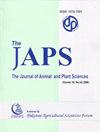GENOMIC ANALYSIS AND EXPRESSION INVESTIGATION OF STEROLEOSIN GENE FAMILY IN ARABIDOPSIS THALIANA
IF 0.5
4区 生物学
Q3 AGRICULTURE, MULTIDISCIPLINARY
引用次数: 1
Abstract
Despite having growing evidence discussing the role of steroleosins in crop plants, their systemic analysis has not been worked extensively. Therefore, bioinformatics tools were employed to study Arabidopsis (Arabidopsis thaliana) steroleosin in comparison with reported Brassica napus and pine steroleosins. Based on molecular weight, eight steroleosins in Arabidopsis were divided into two groups, L-steroleosin (alkalescence) and H-steroleosin (acidity except At5g50770). Phylogeny analysis suggested that H-steroleosins in Arabidopsis are primitive. Moreover, phylogeny, protein alignment, motif analysis and gene structure analysis revealed that the reported steroleosins in B. napus are closely related to H-steroleosins. Similarly, Gene structure analysis revealed an insertion of 10 residues at the C-terminal of H-steroleosin which makes it relatively larger as compared to L-steroleosins. According to the Protein-protein interactions, Arabidopsis steroleosins are interrelated with genes involved in fatty acid biosynthesis and stress tolerance. Duplication studies suggest that among the steroleosin genes in Arabidopsis, segmental duplications are newly developed. Expression analysis suggests that H-steroleosins mainly express in seed tissue, while L-steroleosins diverge in two directions: expression or repression in all tissues. The upstream sequence analysis suggests that Arabidopsis steroleosins are involved in lipid metabolism and the brassinosteroid signaling pathways. The roles of steroleosins for stress responses are indicated by their induced expression under stress and abscisic acid treatments. Therefore, further investigations are required to evaluate the functions of steroleosins in plants.拟南芥甾体蛋白基因家族的基因组分析及表达研究
尽管有越来越多的证据讨论甾体蛋白在作物植物中的作用,但它们的系统分析尚未得到广泛的研究。因此,利用生物信息学工具对拟南芥(Arabidopsis thaliana)甾醇蛋白与报道的甘蓝型油菜和松木甾醇蛋白进行了比较研究。根据分子质量将拟南芥中的8种甾体蛋白分为l -甾体蛋白(碱性)和h -甾体蛋白(酸性,At5g50770除外)。系统发育分析表明,拟南芥中的h -甾体蛋白是原始的。此外,系统发育、蛋白质比对、基序分析和基因结构分析表明,已报道的甘蓝型油菜甾醇蛋白与h -甾醇蛋白密切相关。同样,基因结构分析显示,h -甾体蛋白的c端插入了10个残基,使其相对于l -甾体蛋白更大。根据蛋白-蛋白相互作用,拟南芥甾醇苷与脂肪酸生物合成和胁迫耐受相关基因相关。重复研究表明,拟南芥甾体蛋白基因中出现了片段重复。表达分析表明,h -甾体蛋白主要在种子组织中表达,而l -甾体蛋白在所有组织中均有表达或抑制两个方向。上游序列分析表明拟南芥甾醇苷参与脂质代谢和油菜素内酯信号通路。甾体蛋白在应激和脱落酸处理下的诱导表达表明其在应激反应中的作用。因此,甾体蛋白在植物中的作用有待进一步研究。
本文章由计算机程序翻译,如有差异,请以英文原文为准。
求助全文
约1分钟内获得全文
求助全文
来源期刊

Journal of Animal and Plant Sciences
Multiple-
CiteScore
1.50
自引率
0.00%
发文量
128
审稿时长
6 months
期刊介绍:
The Journal of Animal and Plant Sciences (JAPS) is a bi-monthly publication and is being published regularly since 1991 by the Pakistan Agricultural Scientists Forum (PAS FORUM). It publishes original research papers, review, extension/clinical articles on all aspects of animal (including fisheries/wildlife) and plant sciences, agricultural economics, rural sociology and other related subjects. The journal is read, abstracted and indexed by the abstracting/indexing agencies of international repute.
 求助内容:
求助内容: 应助结果提醒方式:
应助结果提醒方式:


